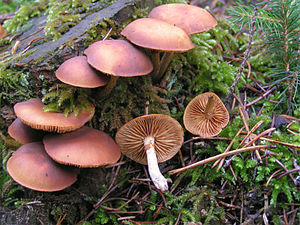Poison hatchet
| Poison hatchet | ||||||||||||
|---|---|---|---|---|---|---|---|---|---|---|---|---|

Poison Häubling ( Galerina marginata var. Autumnalis ) |
||||||||||||
| Systematics | ||||||||||||
|
||||||||||||
| Scientific name | ||||||||||||
| Galerina marginata | ||||||||||||
| ( Batsch ) bolder |
The poison hewling ( Galerina marginata ) - sometimes also called the coniferous hewling , although it also colonizes hardwood - is a poisonous species of fungus from the family of the Trümmling relatives .
features
Macroscopic features
The hat of the poison hatchet is thin, up to 4 cm wide, initially arched and later spread out flat. When wet, it has a honey, ocher to yellow-brown color and a translucent, grooved brim. In the variety of the “skinned hatchet” ( G. marginata var. Autumnalis ) the hat is sticky in damp weather and the grooves are not at all or only weakly pronounced. When it is dry, however, the hat appears yellow-brown. The lamellas have just grown on the stem or run down briefly, stand together and are narrow. Initially pale, they are brown to rust-brown in color with age. The spore powder leaves a light brown imprint. The cylindrical stem has a white fibrous base. Below the mostly ephemeral cuff it is covered with a few light flakes and looks silky-fibrous and silvery shiny along its length. The meat in the hat is yellowish and the handle is dark brown. It smells mainly flour-like, but the smell is also described as "musty, disgusting and similar to rotting wood".
Microscopic features
The almond-shaped spores have a plague . They are approximately 10 × 6.5 micrometers in size. Cheilo- and pleurocystidia are present.
Species delimitation

The poison hatchet is a fungus that can be confused with the edible common stick sponge ( Kuehneromyces mutabilis ). The two species can only be reliably distinguished with the naked eye on the basis of the stalk features. The poison hatchet is characterized by a silvery, longitudinally fibrous stem with a fibrous ring area, whereas the stick sponge has a brown scaly stem with a membranous ring. Other separating features such as B. the floury smell of the poison cape are considered unsafe. There is also a great resemblance to other cockles and some brimstone heads .
toxicology
The toxins of the poison cape are amatoxins and are therefore similar to those of the green leaf mushroom . The lethal dose is said to be around 100–150 g of fresh mushrooms. The first symptoms appear about 5–12 hours after consumption in the form of diarrhea , vomiting, a drop in blood pressure and an increase in pulse. The poison damages the liver. The phalloidin , which can be detected in the fungus, plays no role in the poisoning, since it does not enter the bloodstream when it is ingested orally. See also the article on Phalloids Syndrome .
Ecology and phenology
The poison hawk lives as a saprobiote on dead wood. Its mushroom network is always in contact with wood. In some cases it already settles very rotten wood, often on coniferous wood, which explains the nickname "softwood hawk". However, it can be found just as often on dead hardwood, especially at lower altitudes. It has already been observed that the poison hoodling lived on a trunk together with the stick sponge. The poison hatchet sometimes stands on the ground, apparently without contact with wood. But then the mycelium in the ground is connected to buried wood. The fungus also thrives on bark mulch. Most of the time, the fruiting bodies stand individually and hardly show any similarities with stick sponges.
It usually fructifies in clumps, but also individually, from August to October.
distribution
The poison hatchet is widespread in Central Europe.
swell
- ↑ a b Andreas Gminder, Tanja Böhning: Which mushroom is that? Kosmos, Stuttgart 2007, ISBN 978-3-440-10797-3 .
- ^ Lutz Roth, Hanns Frank, Kurt Kormann: Poison mushrooms, mushroom poisons . Molds - Mycotoxins - Occurrence - Ingredients - Fungal allergies - Food poisoning. Nikol, Hamburg, ISBN 978-3-933203-42-7 (328 pages).
- ↑ Till. R. Lohmeyer, Ute Künkele: Mushrooms . Parragon, ISBN 978-1-4054-8695-8 , pp. 32 .